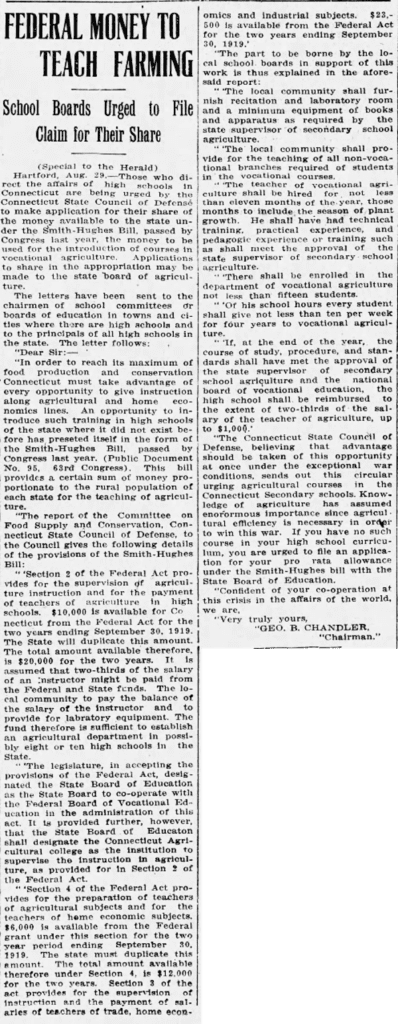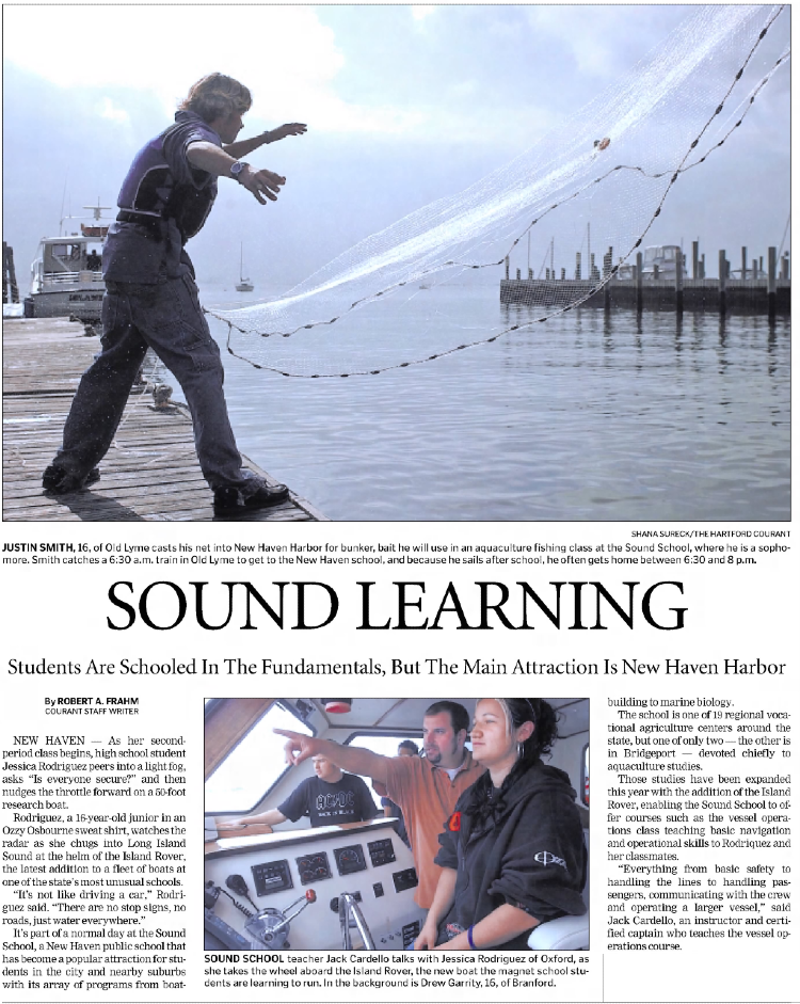In this week’s Footnote we head east. Connecticut was a little late to the FFA party affiliating with the national organization in 1930. They received Charter #40. The FFA charter applications for most states can be found in the online FFA archives, but there is not one on file for Connecticut.
There are 21 FFA chapters in Connecticut and there were 3,364 FFA members in 2021-22. The website for the Connecticut FFA is https://ctffa.org/index.html.
Before Vocational Agriculture – Corn Clubs
If you were a U. S. Congressman, what could you do to keep your name in the public and also make an impact on agriculture in local communities? Augustine Lonergan represented Connecticut’s first congressional district from 1913-1915 and again from 1917 to 1921. Even though he was a lawyer he actively promoted corn clubs known as “Lonergan Corn Clubs.” His office worked with USDA to send information and advice to the boys about growing corn. He was an advocate of “vocational training for agriculture.” For more details see Figure 1.
Lonergan also promoted pig clubs and canning clubs. However his political opponents pointed out that these clubs had been formed elsewhere first and Lonergan did not hold the patent on them.

Figure 1. From the New Britain (CT) Herald, April 30, 1914.
Who Urged Connecticut Schools to Teach Vocational Agriculture in 1917?
After the passage of the Smith-Hughes Act in 1917 who do you think in Connecticut was urging schools to start vocational agriculture programs? It was the Connecticut State Council of Defense. America was in the process of entering World War I and food production and conservation was a high priority. The State Council of Defense sent letters to chairman of school boards and principals of all high schools in the state urging them to start vocational agriculture. They also promoted the idea in newspapers. The article “Federal Money to Teach Farming” published in the New Britain Herald contained detailed information about the Smith-Hughes Act provisions and the responsibilities of the local schools. See Figure 2.

Figure 2. From the New Britain (CT) Herald, August 29, 1917
Double Your Pleasure, Double Your Fun

Figure 3. From the Connecticut FFA website
Can you spot the twins? An advertisement for Doublemint gum had a jingle “Double your pleasure, double you fun.” In 2016-2017 the Connecticut FFA must have had this in mind when they elected twins to be state officers in the FFA (coincidentally California and Montana also had state officer twins in the same year). The two are Desiree (far left) and Hannah LaFontaine (far right). Desiree was the state vice-president and Hannah was the state reporter. They were from the Woodberry FFA chapter.
The Structure of Agricultural Education in Connecticut
An article in the October 17, 1954 issue of the Hartford Courant called for a restructuring of vocational agriculture in Connecticut. A committee had been appointed by the State Education Commissioner to examine the structure of vocational agriculture in the state. Here are excerpts from the article (p. 84):
High schools giving vocational agriculture training should be located to serve the major farming towns of the state, which some of them are not today, and should be operated on a regional basis.
The committee also recommended that the State underwrite part, or all, of the cost of buildings and equipment for these regional agriculture training centers, and might be asked to subsidize tuition for towns which send pupils to these schools.
The recommendations are on their way to the General Assembly in the form of bills.
The consulting committee finds that facilities for instruction are ‘woefully inadequate and unattractive’ in most schools. The courses now being given serve only a third of the major farming towns, and supply less than one-fifth of the number of trained farmers needed…Lack of agricultural education in many high schools has probably caused boys who should be in farming to choose other occupations.
So what happened? I am not sure if the recommendations were acted on then or later but do know the agricultural education programs in Connecticut today reflect these recommendations.
Jennifer Jedd, Ag Ed Program Department Head at Nonnewaug High School which also houses the Ellis Clark Regional Agriscience and Technology Center, explains the structure of agricultural education in Connecticut as follows:
There are 21 ag centers in CT. Each town in CT is districted to one or more ag centers, so students all over the state have the opportunity to attend an ag program by application.
My school serves two towns for the main portion of the school, plus we have the ag program on top of that and we accept students from 13 towns to attend ag, and they attend the school for their regular subject areas too. So the ag class in their schedule takes 1-2 periods of the day and they take regular classes the rest of the day.
Our high school serves a little under 700 students and about 350 of them are ag students. Our chapter is also affiliated so they are all FFA members, making us one of the larger chapters in the country, and we are fortunate to have nine teachers, so we have eight pathways available for our students (floriculture/greenhouse, nursery/landscaping, ag mech, aquaculture, veterinary science, livestock and animal production, equine science, natural resources) and offer some elective courses as well (farm to table, ag business, animal assisted therapy, more to come).
In most centers in CT, all ag students take a survey course then they start to be able to choose their own pathways for the following years after. SAE is also a state requirement, and teachers get some form of compensation to supervise those over the summer.
We have one state staff in the Dept of Education who is devoted to ag for a portion of his time (the rest is other CTE programs), and one other part time FFA executive advisor.
The Sound School
NO! The Sound School is not a music magnet school but one of the 21 regional agricultural education programs. It is a little different than the typical agricultural education program. First it is located on the Long Island sound waterfront in New Haven, CT. Their focus is on maritime education, but they also offer typical agricultural education courses. The school website states they are “Connecticut’s premier aquaculture/agricultural science and technology education center.”
The school was founded in 1981 and has 345 students, 50 faculty and staff and serves 25 school districts. The curriculum includes extensive exposure to on-the-water and water related activities and coursework such as nautical drafting, marine research, aquaculture production, and vessel handling and safety at sea. Students may opt to study the more traditional agricultural courses such as plant science, animal science, agriculture mechanics, and veterinary science. See Figure 4 to see the location of the school. An article about the school is featured in Figure 5.

Figure 4. From Google maps. The red dot is the location of the Sound School.

Figure 5. From the Hartford Courant, October 9, 2005.
Concluding Remarks
During my tenure at North Carolina State University I had the opportunity to supervise the student teaching experience of two NCSU students who had been placed in Connecticut for their student teaching experience. I would catch a nonstop flight on Southwest Airlines at the airport in the early morning and fly to Hartford, CT. At the end of the day I would fly back home. And that was actually less expensive than driving my car to Asheville, NC to supervise a student teacher and return home at the end of the day.
The two students were placed at two different schools in two different years. Each of the schools served as regional agriscience and technology centers. To put it mildly, I was amazed at the agricultural education program at both schools. The facilities were awesome. Each school had five career pathways One school had five agriculture teachers and the other six.
During my 47 years in teaching agricultural education I have been in hundreds of agricultural education programs and have seen many quality programs. The ones in Connecticut certainly rate near the top. They are worth visiting if you get the opportunity.
